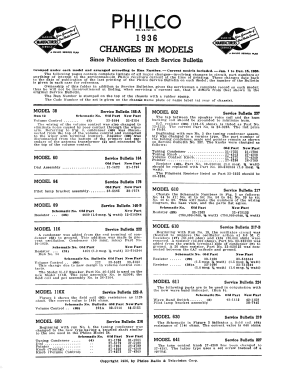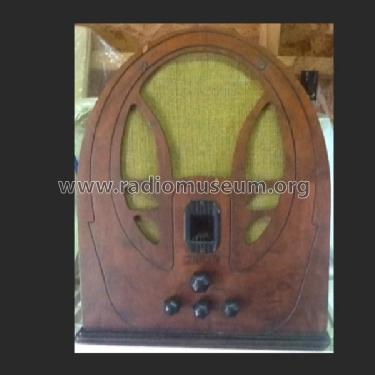89B (89, 89A) Version 4
Philco, Philadelphia Stg. Batt. Co.; USA
- Pays
- Etats-Unis
- Fabricant / Marque
- Philco, Philadelphia Stg. Batt. Co.; USA
- Année
- 1934/1935
- Catégorie
- Radio - ou tuner d'après la guerre 1939-45
- Radiomuseum.org ID
- 114109
Cliquez sur la vignette du schéma pour le demander en tant que document gratuit.
- No. de tubes
- 6
- Principe général
- Super hétérodyne avec étage HF; ZF/IF 260 kHz
- Circuits accordés
- 5 Kreis(e) AM
- Gammes d'ondes
- PO, Police / Maritime et TV (75-200m)
- Tension / type courant
- Alimentation Courant Alternatif (CA) / 115 Volt
- Lautsprecher
- HP dynamique à électro-aimant (électrodynamique)
- Material
- Boitier en bois
- De Radiomuseum.org
- Modèle: 89B [Version 4] - Philco, Philadelphia Stg. Batt
- Form
- Modèle de table vertical cathédrale (dessus arrondi)
- Dimensions (LHP)
- 13.1 x 16.1 x 9.4 inch / 333 x 409 x 239 mm
- Remarques
-
The model 89 series, which was probably Philco's longest-lived model series, includes five versions of the 89B cathedral, three versions of the 89L lowboy, the 89F floor-type console, and the 89LZ chairside with built-in speaker.
Version 1 (1933) of the 89B is a single band radio and has a cabinet similar to model 19B, with front moldings and recessed panel. Version 2 (1933) is also single band, but with a simpler flat-front cabinet with speaker grill similar to version 1. Version 3 (1933-34) has a cabinet similar to version 2, but adds a second band (1.5 - 3.2 MHz). Version 4 (1934-35) has a new style flat-front cabinet with an oval speaker grille with a webbed pattern. Version 5 (1936) has a flat-front cabinet with a continuous arch shape from the base and vertical bars through the speaker grill.
For the 89L lowboy, the early version (1933) is a single band radio and the cabinet has four narrow vertical bars through the speaker grill, along with other embellishment. The middle version(1933-34) has the same cabinet, but with two bands. The late version (1934-35) has a new cabinet design with a central vertical bar through the speaker grill and other embellishment.
The 89F floor-type console (1935) has a tulip-pattern speaker grill and two bands.
The 89LZ chairside is a single band radio and its cabinet is similar to that of the model 19LZ chairside. Although the 89LZ chairside is not yet cataloged by Ramirez, pictures posted here verify its existence.
The model 89 chassis is similar to model 19, but without shadow meter. The standard 89 chassis is for 50-60 Hz power, while chassis marked as 89A (the -A suffix not to be confused with cabinet suffixes for the main model number) are for 25-40 Hz. Early runs of the code 121 chassis are single band, while later runs of 121, as well as codes 123 and 126, have two bands.
The mixer tube changed from type 36 in early models to type 77 in later models, although the date of the change is not clear.
Two Philco schematics (also included in Rider vols. 3 and 7) are available -- one for the early version of code 121 with a single band, and one for code 123 from 1936 with two bands and the updated 77 mixer tube.Stein mentions this model as a single band radio.
- Poids net
- 9 kg / 19 lb 13.2 oz (19.824 lb)
- Prix de mise sur le marché
- 40.00 $
- Source du schéma
- Rider's Perpetual, Volume 7 = 1936 and before
- Littérature
- Machine Age to Jet Age II (page 213.)
- Literatur/Schema (1)
- Philco Radio 1928-1942 (Philco 1928-36 Wiring Diagrams, Parts Lists, and Essential Service Data)
- Literatur/Schema (2)
- Cathedral & Tombstone Radios (page 194.)
- Auteur
- Modèle crée par Konrad Birkner † 12.08.2014. Voir les propositions de modification pour les contributeurs supplémentaires.
- D'autres Modèles
-
Vous pourrez trouver sous ce lien 4086 modèles d'appareils, 2222 avec des images et 3734 avec des schémas.
Tous les appareils de Philco, Philadelphia Stg. Batt. Co.; USA
Collections
Le modèle 89B (89, 89A) fait partie des collections des membres suivants.













































